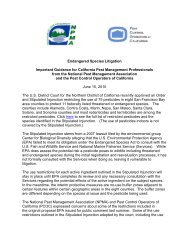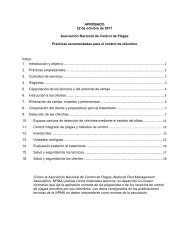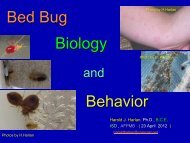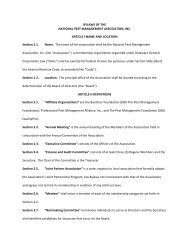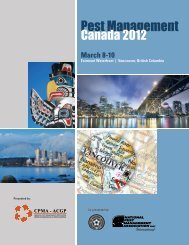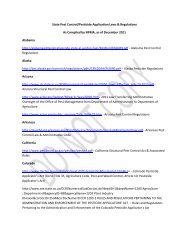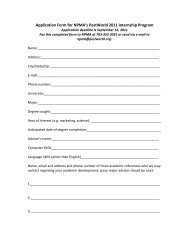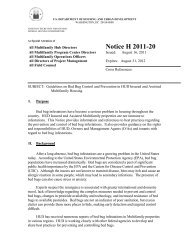Response To Bed Bugs In Hotels - Rodent Removal Chicago
Response To Bed Bugs In Hotels - Rodent Removal Chicago
Response To Bed Bugs In Hotels - Rodent Removal Chicago
Create successful ePaper yourself
Turn your PDF publications into a flip-book with our unique Google optimized e-Paper software.
NPMA GUIDELINES<br />
RESPONSE<br />
TO<br />
BED BUGS<br />
IN HOTELS & LODGING<br />
DEVELOPED BY THE NATIONAL PEST MANAGEMENT ASSOCIATION<br />
Be Proactive<br />
Develop a written “bed bug action plan” with specific policies,<br />
directions, and responsibilities for the following:<br />
• Detecting bed bug evidence through housekeeping,<br />
maintenance, and professional inspections.<br />
• Responding to a bed bug complaint.<br />
• Responding to guests making reservations or at check-in<br />
who want to understand the hotel’s practices concerning<br />
bed bugs.<br />
• Satisfying affected guests.<br />
•<br />
•<br />
•<br />
Eliminating bed bugs.<br />
Returning a room to service.<br />
Managing public relations, including social media,<br />
associated with guest reports of bed bugs.<br />
ommercial lodging is particularly vulnerable to<br />
bed bug problems because of the steady stream of<br />
guests constantly arriving. Each guest is a potential<br />
source of bed bugs hitchhiking on luggage and Cclothing. Lodging facilities and brands can suffer damaging<br />
public relations if the media learns that guests have been<br />
bitten by bed bugs and they can also face the risk of lawsuits.<br />
Managers need to be proactive in monitoring for bed bugs and<br />
aggressive in dealing with them to prevent angry guests and<br />
bad publicity. This protocol provides guidelines for lodging<br />
managers to help them recognize and effectively respond to<br />
bed bug problems.<br />
WHAT TO AVOID<br />
• Do not ignore guest complaints of bites or bugs.<br />
• Do not simply let a room go out of service for a few weeks<br />
and expect the bed bugs to go away.<br />
• Do not try to control bed bugs without an experienced<br />
pest management professional.<br />
• Do not ignore rooms adjacent to (as well as above and<br />
below) those with a bed bug problem.<br />
• Do not put a room back in service until reasonably sure<br />
that the bed bugs have been eliminated and all old<br />
evidence of bed bugs has been removed.<br />
Provide training for front desk, maintenance, and housekeeping<br />
staff on the following topics:<br />
• How bed bugs are introduced and spread in lodging<br />
facilities.<br />
• How to look for and identify signs of bed bugs.<br />
• Basic bed bug biology and habits.<br />
• What to do if they find evidence of bed bugs.<br />
• How to avoid spreading bed bugs from one room to<br />
another.<br />
• How to respond to a bed bug complaint.<br />
• Steps to satisfy affected guests.<br />
• Consider posting written information about bed bugs and<br />
your property’s proactive control plans.<br />
Respond Quickly to<br />
a <strong>Bed</strong> Bug <strong>In</strong>cident<br />
• Respond empathetically to a guest complaint and treat<br />
all reports as the highest priority. At a minimum, offer to<br />
move the guest to a new room.<br />
• Take the suspected room out of service until bed bugs<br />
have been eliminated or inspection reveals that the initial<br />
report was incorrect.<br />
• Arrange for an inspection by a pest management<br />
professional as soon as possible.<br />
-- The inspection should include the room in question, as<br />
well as rooms adjacent to, above, and below the initial
NPMA GUIDELINES TO BED BUGS<br />
HOTELS & LODGING<br />
•<br />
suspected room. The room to which the affected<br />
guest was moved should also be inspected.<br />
-- Any room confirmed to have bed bugs should be<br />
taken out of service immediately.<br />
Immediately schedule all rooms discovered to contain bed<br />
bugs for professional pest control service.<br />
-- Every room receiving bed bug control service should<br />
be re-inspected following treatment and serviced<br />
again as necessary. The appropriate time frame<br />
for re-inspection will be determined by the pest<br />
management professional, based on the type of<br />
treatment performed.<br />
-- Rooms should stay out of service until control has<br />
been confirmed by a pest management professional.<br />
-- After rooms have been placed back in service, have<br />
them re-inspected regularly for two to three months<br />
to ensure that low-level populations have not been<br />
missed.<br />
-- Thoroughly document all actions.<br />
checking mattress for bed bugs<br />
Take Action to Detect <strong>Bed</strong> <strong>Bugs</strong><br />
Early and Prevent Their Spread<br />
• Consider scheduling regular bed bug inspections of all<br />
rooms (including public areas) by a pest management<br />
professional.<br />
• Housekeeping staff should inspect for evidence of bed<br />
bugs during every room service, and maintenance staff<br />
should remove and check behind headboards and<br />
under box springs periodically.<br />
Consider enclosing mattresses and box springs with<br />
•<br />
bed bug proof encasements.<br />
• Follow proper laundry handling practices to reduce the<br />
risk of spreading bed bugs:<br />
-- Keep clean and dirty laundry separate at all times.<br />
-- Keep carts in the hallway during room service.<br />
• Take precautions if removing beds and furniture from<br />
infested rooms:<br />
-- If items are to be removed from infested rooms,<br />
wrap mattresses, box springs, and furniture in<br />
plastic and tape them to avoid dropping bed bugs<br />
or their eggs while transporting the items out of<br />
the building.<br />
-- Do not store infested items with other furniture<br />
until they have been disinfested.<br />
• Eliminate bed bug hiding places where possible.<br />
Examples of bed bug hiding places include peeling<br />
wallpaper and paint, cracks and holes in wall and<br />
floors, crevices around head boards, crevices along<br />
baseboards and molding and around heating and A/C<br />
units.<br />
• Avoid used or reconditioned furniture and furnishings<br />
•<br />
•<br />
(including antiques) or have them inspected and<br />
disinfested before installation.<br />
Vacuum rooms thoroughly including often overlooked<br />
sites such as drapes, the back side of pictures, and the<br />
underside of furniture, all known hiding spots for bed<br />
bugs.<br />
Consider ways to make bed bugs easier to detect when<br />
redesigning guest rooms. Consider fewer fabrics, less<br />
clutter, white bedding, etc. as possible considerations.<br />
bed bug on skin<br />
For detailed information on bed bugs, control options,<br />
guidance on working with professionals or to find a<br />
local pest management professional, please visit<br />
www.pestworld.org.<br />
www.pestworld.org



